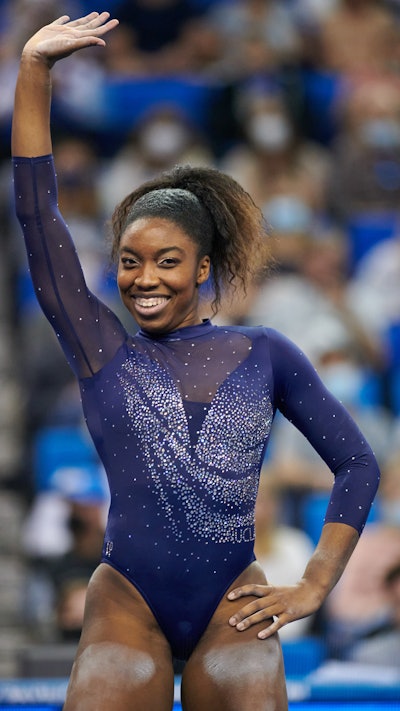 Chae Campbell
Chae Campbell
Collegiate gymnastics has exploded in popularity in recent years as young women of color lead in routines that generate praise and inspire conversations.
“Every single individual and all-around champion at NCAAs this year was a woman of color,” says Umme Salim-Beasley, head gymnastics coach at Rutgers University.
Momentum
Salim-Beasley says when she got involved in gymnastics in the 1980s, there were only a few Black gymnasts. She didn’t see diversity in elite gymnastics nor in college gymnastics.
“Those little girls watching gymnastics on television were not recognizing that it was a sport for them,” says Salim-Beasley. Olympians Dominique Dawes, Betty Okino, Gabby Douglas, and Simone Biles helped build momentum to increase representation in the sport. “There has been much more of an explosion of Black girls going into gymnastics because their parents are seeing that it is a welcoming sport,” she says.
Salim-Beasley says younger girls are seeing the fun of the sport when they watch collegiate gymnastics. As they progress, these girls may realize elite gymnastics is not the track for them, but collegiate gymnastics may be a great fit.
“There is a lot more access to seeing gymnastics,” says Salim-Beasley.
Collegiate gymnastics has multiple meets each season airing on various platforms, from ESPNU to conference television networks to online streaming. But most people watch elite gymnastics every four years during the Olympics, according to Wendy Hilliard, the first African American rhythmic gymnast to represent the U.S. at the Olympic Games.
“You get a chance to follow people for a season,” says Hilliard, founder of the Wendy Hilliard Gymnastics Foundation, which provides low-cost or free gymnastics instruction to girls and boys from underserved communities.
Chae Campbell, a sophomore at UCLA, says she had been training on an elite Olympic track, but an injury put an end to that quest. She turned her attention toward collegiate gymnastics and focused on UCLA in her mid-teens.
“Competing in college was one of my main goals,” Campbell says. “As I got older, I discovered what college had to offer. With UCLA there was something unique and different, and it wasn’t like any other college program. They had a star quality; they weren’t just doing the moves. Their showmanship and performance qualities were unique.”
The heart of the UCLA Bruins gymnastics program was developed by Valorie Kondos Field, the head coach from 1991 to 2019. She was named Pac-12 Gymnastics Coach of the Century. Kondos Field had been a professional ballet dancer. After retiring from dance, she attended UCLA and became an assistant coach and choreographer for the gymnastics team. She recruited Campbell prior to her retirement.
“She told me UCLA wants you to be an individual,” says Campbell. “I took that to heart.”
Originality
Viral videos have made a difference in the exposure of college gymnastics, says Hilliard. The biggest changemaker was Katelyn Ohashi, a graduate of UCLA. A few years ago, Hilliard and Ohashi were doing a gymnastics clinic together when Ohashi said she needed to choreograph another floor routine that would go viral.
“She was thinking in her head about her next routine, which blew up when she did Tina Turner,” says Hilliard. “She was choreographing her routine with this in mind. I have to give it to Val Kondos Field. She came from the world of dance and performing, so she understood performance gymnastics.”
Social media also has had a positive influence on the sport. Salim-Beasley says collegiate gymnasts are “monsters of social media.” They use Instagram and Tik Tok to show their personalities, which resonates with young gymnasts. There is considerable diversity on her Rutgers roster, and she garners interest from many young gymnasts of color who want to be Scarlet Knights.
There is still room for improvement, in terms of coaching diversity, as there are only a handful of African-American head and assistant coaches in Division I gymnastics. But the launch of new programs could bring more opportunities to the increasingly popular sport. Hallie Mossett, a graduate of UCLA, is the assistant coach at Long Island University (LIU), a program that launched in 2020.
“I’m thankful that I’m able to be part of building the culture of a program that does celebrate everyone and is really inclusive,” says Mossett. “I love to see our progress that we make every single competition.
“I hope to see the sport evolve, and I want to see it more diverse,” she continues. “I want to see more Black coaches. I hope by us being there, we’re able to expand the diversity in the sport—coaches, gymnasts, judges, administrators, everything.”
Earlier this year, Fisk University became the first HBCU to launch a gymnastics program. Corrine Tarver has been named head coach, and she is recruiting to compete next season. “Since announcing the first HBCU women’s gymnastics program, we have seen an amazing outpouring of support,” says Fisk President Dr. Vann Newkirk Sr.
Salim-Beasley, for one, is excited to see the development of Fisk’s gymnastics program and anticipates more HBCUs launching programs.
Delivering a message
When Salim-Beasley was a young gymnast in the club world, she performed what the judges were looking for. American gymnasts were generally trying to mimic European style gymnastics to score well. Expressing your personality wasn’t the plan.
As a young gymnast it was hard not to conform, but Mossett always wanted to stand out. Even as a student-athlete, she choreographed routines for her teammates. Her final year competing, she wanted to have a floor routine that embraced her culture.
“I started lying on floor, I had a flexibility pose, but I did have a Black Power fist,” says Mossett. “I hadn’t seen anyone else do that before. I wouldn’t say it was nerve-racking, but it was definitely different. I embraced that challenge, and I’m so happy I was able to do that and hopefully inspire some more of the viral routines that embraced Black Power.”
Today, much has changed
“College gymnastics is a very different outlook,” says Salim-Beasley, who says many of the floor routines gymnasts at Rutgers perform come from the gymnasts’ own ideas. “College judges are looking for personality. They’ve been very accepting to letting gymnasts perform in the way they want to perform.”
And the sport has evolved to be “definitely a platform for expression,” says Salim-Beasley. “A lot of universities have meets for expressive purposes. They have diversity and inclusion meets. They want to create awareness in multiple areas.”
Last year, videos of floor routines from UCLA gymnasts Nia Dennis, who used stepping and hip hop, and Margzetta Frazier, set to Janet Jackson music, went viral. Although Kondos Field retired in 2019, Hilliard says she instilled in the program attention to detail around making routines exciting.
“The athletes had an extra sense of how they could reach people with a viral floor routine with really exciting music and be able to do the gymnastics and dance that they felt inspired to do,” says Hilliard. “In the last two years, the awareness, Black Lives Matter, being able to express yourself, it all comes together. It gives you the inspiration and the strength to speak to it. This is their platform and they’re using it.”
Campbell says she’s worked on her floor routines with assistant coach BJ Das, who also comes from the dance world. “She understands that dancing is not just posing; it is telling a story,” says Campbell.
Campbell’s most recent floor routine was a tribute to Dancehall and telling the story of the joy that Dancehall showcase when it comes to authentic Jamaican moves that are popular. “I want everyone to be invited into that and experience it with me,” she notes.
“It is so special, and it shows how far we’ve really come,” says Campbell, who joined teammates in giving a Black Power salute at a 2021 Black Excellence meet. “It’s not just UCLA, but it’s other schools also joining in on this. To see it growing and more people feeling empowered, it’s a sense of unity that I love to see across all schools.”















